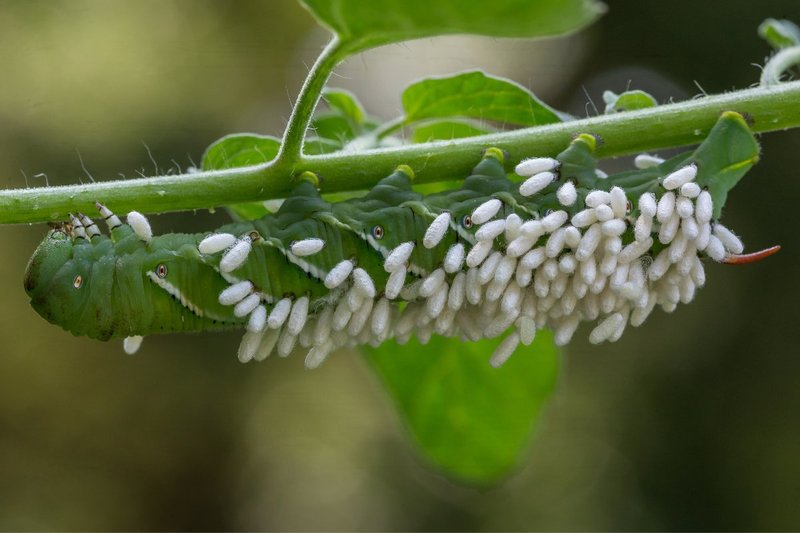
Hornworms are the larval stage of the hawk moth, and they lay their eggs on the leaves of plants, particularly in the nightshade family like tomatoes and peppers. Spotting these eggs can feel like finding a needle in a haystack, especially if you’re not sure what you’re looking for. So, let’s dive into how to identify hornworm eggs on leaves, so you can keep your garden healthy and thriving.
What Do Hornworm Eggs Look Like?
Hornworm eggs are tiny—often less than a millimeter in size—and are generally round or oval-shaped. They usually have a smooth surface, making them blend in with the plant’s leaves. Most commonly, you’ll find them in clusters that look like small, pale green or white beads. This coloration helps them camouflage against the leaves, which can make spotting them quite tricky.
The eggs typically cluster on the underside of leaves, which offers them protection from birds and other predators. So, if you’re scanning your plants, be sure to flip a few leaves over. Think of it like checking for the hidden gems in a treasure hunt!
Why Identifying Them Early Matters
You might be wondering why it’s so crucial to spot these eggs early. The earlier you identify hornworm eggs, the easier it is to control the problem before it escalates. Once they hatch, hornworm larvae can grow quickly, consuming large amounts of foliage and even entire plants in just a few days.
If you can catch them before they become larvae, you’ll save your plants from significant damage. It’s like catching a cold before it turns into the flu; prevention is always easier than treatment!
Where Are Hornworm Eggs Typically Found?
Hornworm eggs are not just found haphazardly; they have favorite spots. You’ll often find them clustered on the leaves of tomatoes, peppers, eggplants, and other plants in the nightshade family. So, if you have a vegetable garden, keep a close eye on these plants.
Typically, the eggs are found on the underside of the leaves, as mentioned earlier. They prefer to stay hidden from predators, so when you’re inspecting your plants, it’s essential to look closely. It’s a bit like searching for the best hiding spots during a game of hide and seek!
Best Times to Look for Eggs
Early morning or late afternoon are the best times to check for hornworm eggs. During these times, the garden is usually calm and quiet, making it easier to spot any potential threats. The best part? The sunlight can help illuminate the area, making those shiny little eggs stand out a bit more.
Also, remember that hornworm moths typically lay their eggs at night. So, if you inspect your plants in the morning, you’re likely catching them shortly after they’ve been laid. This timing could be your garden’s saving grace!
What Should You Do If You Find Hornworm Eggs?
If you spot the eggs, don’t panic! Here’s what you can do. First, gently scrape the eggs off the leaves using your fingernail or a soft brush. Be sure to dispose of them far from your garden to prevent them from hatching nearby.
If you find a lot of eggs or if they keep coming back, consider using natural predators like wasps that target hornworms. Introducing these beneficial insects can help keep your garden in balance. Think of it as inviting a friendly bouncer to your party to keep out the troublemakers.
Preventive Measures to Consider
Prevention is always better than cure. Here are some tips to reduce the chances of hornworm eggs showing up in your garden:
- Regularly monitor your plants, inspecting both sides of the leaves.
- Encourage beneficial insects that feed on hornworms.
- Keep your garden healthy by rotating crops each year.
By taking these steps, you can help minimize the chance of hornworm problems in the future.
Using Traps and Pesticides Wisely
Sometimes, you’ll need a little extra help. If eggs become a recurring issue, you might want to consider traps or even pesticides. However, be cautious! Look for products that are safe for your plants and the environment.
Organic pesticides can be a great option since they typically target pests without harming beneficial insects. Just make sure to follow the instructions carefully; over-application can lead to more harm than good.
Using traps can also be effective. You can hang yellow sticky traps around your plants, which lure and capture adult moths before they lay their eggs. It’s a simple yet effective way to keep your plants healthy.
Creating A Balanced Ecosystem
One of the most effective ways to manage pests like hornworms is to create a balanced ecosystem in your garden. When you have a mix of plants and healthy biodiversity, natural predators will thrive, helping to keep pest populations in check.
Consider planting flowers that attract beneficial insects or using companion planting techniques. For example, marigolds are known to repel certain pests and attract beneficial ones. It’s all about inviting the right guests to your garden party!
Identifying hornworm eggs on leaves might seem daunting at first, but with a little practice, you’ll be a pro in no time. Remember to check your plants regularly, look for those tiny clusters of eggs, and take action at the first sign of trouble.
By staying vigilant and employing preventive measures, you can keep your garden healthy and thriving. And who doesn’t want to enjoy a bountiful harvest without the worry of pesky hornworms ruining their efforts? Happy gardening!

